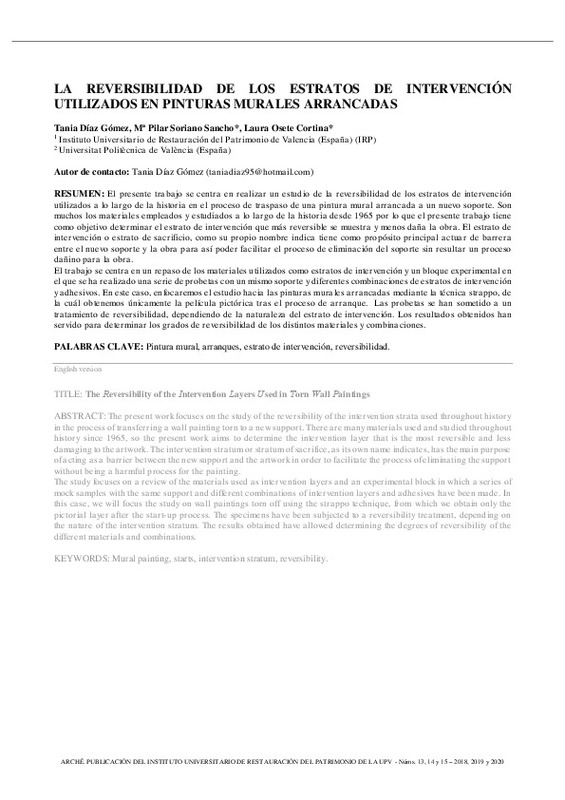|
[ES] El presente trabajo se centra en realizar un estudio de la reversibilidad de los estratos de intervención utilizados a lo largo de la historia en el proceso de traspaso de una pintura mural arrancada a un nuevo soporte. ...[+]
[ES] El presente trabajo se centra en realizar un estudio de la reversibilidad de los estratos de intervención utilizados a lo largo de la historia en el proceso de traspaso de una pintura mural arrancada a un nuevo soporte. Son muchos los materiales empleados y estudiados a lo largo de la historia desde 1965 por lo que el presente trabajo tiene como objetivo determinar el estrato de intervención que más reversible se muestra y menos daña la obra. El estrato de intervención o estrato de sacrificio, como su propio nombre indica tiene como propósito principal actuar de barrera entre el nuevo soporte y la obra para así poder facilitar el proceso de eliminación del soporte sin resultar un proceso dañino para la obra. El trabajo se centra en un repaso de los materiales utilizados como estratos de intervención y un bloque experimental en el que se ha realizado una serie de probetas con un mismo soporte y diferentes combinaciones de estratos de intervención y adhesivos. En este caso, enfocaremos el estudio hacia las pinturas murales arrancadas mediante la técnica strappo, de la cuál obtenemos únicamente la película pictórica tras el proceso de arranque. Las probetas se han sometido a un tratamiento de reversibilidad, dependiendo de la naturaleza del estrato de intervención. Los resultados obtenidos han servido para determinar los grados de reversibilidad de los distintos materiales y combinaciones.
[-]
[EN] The present work focuses on the study of the reversibility of the intervention strata used throughout history
in the process of transferring a wall painting torn to a new support. There are many materials used and ...[+]
[EN] The present work focuses on the study of the reversibility of the intervention strata used throughout history
in the process of transferring a wall painting torn to a new support. There are many materials used and studied throughout
history since 1965, so the present work aims to determine the intervention layer that is the most reversible and less
damaging to the artwork. The intervention stratum or stratum of sacrifice, as its own name indicates, has the main purpose
of acting as a barrier between the new support and the artwork in order to facilitate the process of eliminating the support
without being a harmful process for the painting.
The study focuses on a review of the materials used as intervention layers and an experimental block in which a series of
mock samples with the same support and different combinations of intervention layers and adhesives have been made. In
this case, we will focus the study on wall paintings torn off using the strappo technique, from which we obtain only the
pictorial layer after the start-up process. The specimens have been subjected to a reversibility treatment, depending on
the nature of the intervention stratum. The results obtained have allowed determining the degrees of reversibility of the
different materials and combinations.
[-]
|







